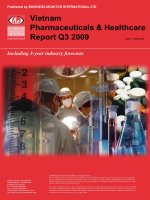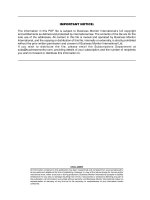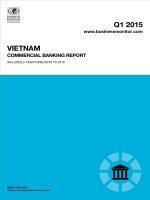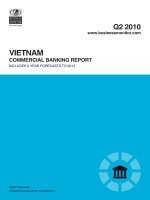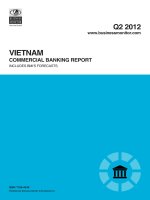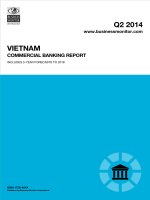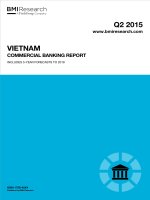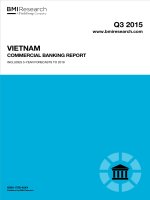Vietnam pharmaceuticals healthcare report q2 2015
Bạn đang xem bản rút gọn của tài liệu. Xem và tải ngay bản đầy đủ của tài liệu tại đây (638.61 KB, 127 trang )
Q2 2015
www.bmiresearch.com
VIETNAM
PHARMACEUTICALS & HEALTHCARE REPORT
INCLUDES 10-YEAR FORECASTS TO 2024
ISSN 1748-2305
Published by:BMI Research
Vietnam Pharmaceuticals & Healthcare
Report Q2 2015
INCLUDES 10-YEAR FORECASTS TO 2024
Part of BMI’s Industry Report & Forecasts Series
Published by: BMI Research
Copy deadline: March 2015
BMI Research
Senator House
85 Queen Victoria Street
London
EC4V 4AB
United Kingdom
Tel: +44 (0) 20 7248 0468
Fax: +44 (0) 20 7248 0467
Email:
Web:
© 2015 Business Monitor International Ltd
All rights reserved.
All information contained in this publication is
copyrighted in the name of Business Monitor
International Ltd, and as such no part of this
publication may be reproduced, repackaged,
redistributed, resold in whole or in any part, or used
in any form or by any means graphic, electronic or
mechanical, including photocopying, recording,
taping, or by information storage or retrieval, or by
any other means, without the express written consent
of the publisher.
DISCLAIMER
All information contained in this publication has been researched and compiled from sources believed to be accurate and reliable at the time of
publishing. However, in view of the natural scope for human and/or mechanical error, either at source or during production, Business Monitor
International Ltd accepts no liability whatsoever for any loss or damage resulting from errors, inaccuracies or omissions affecting any part of the
publication. All information is provided without warranty, and Business Monitor International Ltd makes no representation of warranty of any kind
as to the accuracy or completeness of any information hereto contained.
Vietnam Pharmaceuticals & Healthcare
Report Q2 2015
INCLUDES 10-YEAR FORECASTS TO 2024
Part of BMI’s Industry Report & Forecasts Series
Published by: BMI Research
Copy deadline: March 2015
BMI Research
Senator House
85 Queen Victoria Street
London
EC4V 4AB
United Kingdom
Tel: +44 (0) 20 7248 0468
Fax: +44 (0) 20 7248 0467
Email:
Web:
© 2015 Business Monitor International Ltd
All rights reserved.
All information contained in this publication is
copyrighted in the name of Business Monitor
International Ltd, and as such no part of this
publication may be reproduced, repackaged,
redistributed, resold in whole or in any part, or used
in any form or by any means graphic, electronic or
mechanical, including photocopying, recording,
taping, or by information storage or retrieval, or by
any other means, without the express written consent
of the publisher.
DISCLAIMER
All information contained in this publication has been researched and compiled from sources believed to be accurate and reliable at the time of
publishing. However, in view of the natural scope for human and/or mechanical error, either at source or during production, Business Monitor
International Ltd accepts no liability whatsoever for any loss or damage resulting from errors, inaccuracies or omissions affecting any part of the
publication. All information is provided without warranty, and Business Monitor International Ltd makes no representation of warranty of any kind
as to the accuracy or completeness of any information hereto contained.
CONTENTS
BMI Industry View 7
SWOT 9
Political 11
Economic 12
Operational Risk 14
Industry Forecast 16
Pharmaceutical Market Forecast 16
Table: Pharmaceutical Sales, Historical Data And Forecasts (Vietnam 2011-2019) 17
Healthcare Market Forecast 19
Table: Healthcare Expenditure Trends, Historical Data And Forecasts (Vietnam 2011-2019) 22
Table: Government Healthcare Expenditure Trends, Historical Data And Forecasts (Vietnam 2011-2019) 23
Table: Private Healthcare Expenditure Trends, Historical Data And Forecasts (Vietnam 2011-2019) 23
Prescription Drug Market Forecast 24
Table: Prescription Drug Market Indicators, Historical Data And Forecasts (Vietnam 2011-2019) 25
Patented Drug Market Forecast 26
Table: Patented Drug Market Indicators, Historical Data And Forecasts (Vietnam 2011-2019) 27
Generic Drug Market Forecast 28
Table: Generic Drug Market Indicators, Historical Data And Forecasts (Vietnam 2011-2019) 29
OTC Medicine Market Forecast 30
Table: Over-The-Counter (OTC) Medicine Market Indicators, Historical Data And Forecasts (Vietnam 2011-2019) 31
Pharmaceutical Trade Forecast 32
Table: Pharmaceutical Trade Data And Forecasts (Vietnam 2013-2019) 33
Table: Pharmaceutical Trade Data And Forecasts local currency (Vietnam 2013-2019) 34
Key Risks To BMI's Forecast Scenario 34
Macroeconomic Forecasts 35
Economic Analysis 35
Table: Economic Activity (Vietnam 2010-2019) 39
Industry Risk Reward Index 40
Asia Pacific Risk/Reward Index 40
Vietnam Risk Reward Index 46
Rewards 46
Risks 46
Market Overview 48
Industry Trends And Developments 50
Epidemiology 50
Healthcare Sector 52
Vietnam Pharmaceuticals & Healthcare Report Q2 2015
© Business Monitor International Ltd Page 4
Hospital Sector 54
Table: Healthcare Resources, Healthcare Activity and Healthcare Personnel 55
Private Healthcare Sector 58
Healthcare Insurance 60
Healthcare And Pharmaceutical Reform 61
Research And Development 62
Biotechnology Sector 63
Clinical Trials 65
Regulatory Development 68
Pharmaceutical Advertising 69
Intellectual Property Issues 70
Corruption 73
Pricing Regime 74
Reimbursement Regime 79
Pricing And Reimbursement Developments 80
Competitive Landscape 82
Research-Based Industry 82
Domestic Industry 83
Foreign Industry 84
Traditional Medicines 86
Pharmaceutical Distribution 87
Pharmaceutical Retail Sector 88
Table: Key Aspects Of Good Pharmacy Practice In Developing Countries 89
Company Profile 90
DHG Pharmaceutical 90
GlaxoSmithKline 92
Merck & Co 94
Novartis 96
Pfizer 98
Sanofi 100
Traphaco Pharmaceutical 103
Vietnam OPV Pharmaceutical Co 105
Vietnam Pharmaceutical Corporation (Vinapharm) 107
Vietnam Pharmaceutical Joint Stock Company (Ampharco) 110
Vidipha Central Pharmaceutical Joint Stock Company 112
Demographic Forecast 114
Table: Population Headline Indicators (Vietnam 1990-2025) 115
Table: Key Population Ratios (Vietnam 1990-2025) 115
Table: Urban/Rural Population & Life Expectancy (Vietnam 1990-2025) 116
Table: Population By Age Group (Vietnam 1990-2025) 116
Table: Population By Age Group % (Vietnam 1990-2025) 117
Vietnam Pharmaceuticals & Healthcare Report Q2 2015
© Business Monitor International Ltd Page 5
Glossary 119
Methodology 121
Pharmaceutical Expenditure Forecast Model 121
Healthcare Expenditure Forecast Model 121
Notes On Methodology 122
Risk/Reward Index Methodology 123
Index Overview 124
Table: Pharmaceutical Risk/Reward Index Indicators 124
Indicator Weightings 125
Vietnam Pharmaceuticals & Healthcare Report Q2 2015
© Business Monitor International Ltd Page 6
BMI Industry View
BMI View: Vietnam's underdeveloped healthcare system will continue to be an impediment to
pharmaceutical companies as patients face challenges in accessing drugs. This challenge is further
compounded by the regional variations in healthcare infrastructure, including a concentration of doctors
and hospital facilities in the urban provinces of the country.
Headline Expenditure Projections
■
Pharmaceuticals: VND80,731bn (USD3.81bn) in 2014 to VND92,719bn (USD4.32bn) in 2015; +14.8%
in local currency terms and +13.4% in US dollar terms.
■
Healthcare: VND254,679bn (USD12.01bn) in 2014 to VND291,313bn (USD13.57bn) in 2015; +14.4%
in local currency terms and +12.9% in US dollar terms.
Risk Reward Index:
Vietnam's Pharmaceutical Risk Reward Index score for Q215 is 49.1 out of the maximum 100. The country
scored above average for some indicators and sub-indicators, including overall market expenditure, sector
value growth and pensionable population. Consequently, with this moderate score, Vietnam is ranked 11th
out of the 19 key Asia Pacific markets, level with Thailand and Indonesia.
Key Trends And Developments
■
In March the Vietnamese government has announced its target to achieve 75% health insurance coverage
in 2015 and 80% by 2020, reports Vietnamnet, citing Prime Minister Nguyen Tan Dung. Currently,
health insurance coverage is available only to a small number of households just above the poverty line
and employees of private firms, according to the blueprint for universal health insurance. Health
insurance covered 71.6% of the population in 2014. This low coverage is attributed to high premiums,
low medical service quality and hurdles in insurance payments, noted Health Minister Nguyen Thi Kim
Tien. Cooperation and initiative from the entire system is required to overhaul existing policies in order
to extend coverage to the remaining 30% of the population, stressed Kim Tien.
■
Eight state-owned pharmaceutical companies in Vietnam are set to go public in 2015, reports Deal Street
Asia. Vinapharm, Central Pharmacy 1, Central Pharmacy 2, Vietnam Medical Equipment and DK
Pharma have all slated initial public offerings (IPO) in Q215, while another three companies will offer
shares to the public by end-2015. The move comes after the Vietnamese Ministry of Health urged
companies under its management to fast track the process of equitisation since only one pharmaceutical
firm, Foripharm Central Pharma No 3, was privatised in 2014. The delay in the process of equitisation
is attributed to the long procedure of analysing the value of the corporations. There are approximately 35
companies under the health ministry's management, out of which 25 firms auctioned their shares in 2007.
■
Vietnam's pharmaceutical industry could benefit from the production and marketing of some of the total
4,000 plant species used in traditional medicines, reports Nong Thon Ngay Nay, citing Drug
Administration Director Truong Quoc Cuong in February. The Government has already asked the health
Vietnam Pharmaceuticals & Healthcare Report Q2 2015
© Business Monitor International Ltd Page 7
ministry to develop the Vietnamese traditional medicine industry in order to reduce the country's
dependence on imports. The country imports 90% of its pharmaceutical materials. The national
pharmaceutical industry development strategy requires the pharmaceutical industry to meet 80% of the
country's medicine demand by 2020.
BMI Economic View: Sustained growth momentum in Vietnam's manufacturing sector (which accounts
for about 19.0% of nominal GDP) and ongoing attempts by the Vietnamese government to strengthen
domestic banks have reinforced our positive outlook for the economy in 2015. As such, we continue to
forecast Vietnam's real GDP growth at 6.4% in 2015, placing it well above market consensus of 6.0% and
representing an increase from the 6.0% growth rate in 2014.
BMI Political View: The Communist Party of Vietnam (CPV)'s 12th National Congress, which will
convene in January 2016, will maintain current pro-growth economic policies, but eschew political
liberalisation. One of the CPV's biggest challenges will be cracking down on corruption. Meanwhile, the
emergence of a new generation of CPV officials could lead to rifts with the old guard over the pace of
reform, leading to policy confusion.
Vietnam Pharmaceuticals & Healthcare Report Q2 2015
© Business Monitor International Ltd Page 8
SWOT
SWOT Analysis
Strengths
■
Significant growth potential, given a large and growing population.
■
The government's commitment to developing the health sector.
■
Sizeable local generic drugs sector, which is being encouraged by the government.
■
Strong traditional medicines segment with potential to improve the non-prescription
drugs market in the longer term, as long as sufficient investment in extraction
technologies can be found.
Weaknesses
■
One of the least developed pharmaceutical markets in Asia, with low per capita
spending on drugs.
■
Counterfeit drugs account for a significant amount of market consumption.
■
No bioequivalence requirement in place for locally made generic medicines.
■
Little distinction made between prescription and over-the-counter drugs, with most
medicines available without a prescription.
■
Complex drug pricing policy biased towards local drug producers.
■
Import-reliant market, especially in terms of high-tech products and active
pharmaceutical ingredients, which makes it vulnerable to currency movements.
■
Underdeveloped primary care services and a shortage of trained pharmacists are
continuing to hamper access to medicines and product market penetration.
■
Population concentrated in rural, rather than urban, areas, preventing access to
modern drugs and encouraging dependence upon traditional medicines.
Opportunities
■
The Association of Southeast Asian Nations (ASEAN) harmonisation initiative,
including the adoption of Western regulatory standards such as International
Conference on Harmonisation and World Health Organization guidelines.
Vietnam Pharmaceuticals & Healthcare Report Q2 2015
© Business Monitor International Ltd Page 9
SWOT Analysis - Continued
■
Introduction of five-year exclusivity for clinical dossier data encouraging research-
based multinationals.
■
If investment can be found for technological improvements, then there is great
potential in the traditional Chinese medicine market, in addition to fledging
biotechnology.
■
Full World Trade Organization membership improving the trading climate and
potentially, in the longer term, redressing pharmaceutical trade issues.
■
Requirement for domestic companies to comply with international good
manufacturing practices should boost exports.
Threats
■
Government resistance to aligning patent law fully with international standards
deterring multinational sector expansion.
■
Need to resolve infrastructural and power supply issues, as well as higher education
provision, before higher levels of foreign direct investment can be expected.
■
The government is increasingly interfering in the industry, protecting indigenous firms
through the use of legal trade barriers, which will affect competitiveness.
■
Pharmaceutical price inflation threatens to put medicines out of reach of the poor and
therefore limit market volume growth.
■
Legalisation of parallel imports negatively impacting performance of patented drugs.
Vietnam Pharmaceuticals & Healthcare Report Q2 2015
© Business Monitor International Ltd Page 10
Political
SWOT Analysis
Strengths
■
The Communist Party of Vietnam remains committed to market-oriented reforms and
we do not expect major shifts in policy direction over the next five years. The one-
party system is generally conducive to short-term political stability.
■
Relations with the US have witnessed a marked improvement, and Washington sees
Hanoi as a potential geopolitical ally in South East Asia.
Weaknesses
■
Corruption among government officials poses a major threat to the legitimacy of the
ruling Communist Party.
■
There is increasing (albeit still limited) public dissatisfaction with the leadership's tight
control over political dissent.
Opportunities
■
The government recognises the threat corruption poses to its legitimacy, and has
acted to clamp down on graft among party officials.
■
Vietnam has allowed legislators to become more vocal in criticising government
policies. This is opening up opportunities for more checks and balances within the
one-party system.
Threats
■
Although strong domestic control will ensure little change to Vietnam's political scene
in the next few years, over the longer term, the one-party-state will probably be
unsustainable.
■
Relations with China have deteriorated over recent years due to Beijing's more
assertive stance over disputed islands in the South China Sea and domestic criticism
of a large Chinese investment into a bauxite mining project in the central highlands,
which could potentially cause wide-scale environmental damage.
Vietnam Pharmaceuticals & Healthcare Report Q2 2015
© Business Monitor International Ltd Page 11
Economic
SWOT Analysis
Strengths
■
Vietnam has been one of the fastest-growing economies in Asia in recent years, with
GDP growth averaging 6.6% annually between 2000 and 2013.
■
The economic boom has lifted many Vietnamese out of poverty, with the official
poverty rate in the country falling from 58% in 1993 to 17.2% in 2012.
■
Vietnam has been strengthening its trade and aid ties in a bid to increase exports and
diversify its export sector.
Weaknesses
■
Vietnam still suffers from fiscal deficits, leaving the economy vulnerable to global
economic uncertainties. The fiscal deficit is dominated by substantial spending on
social subsidies that could be difficult to withdraw.
■
The heavily-managed and weak currency reduces incentives to improve quality of
exports, and also keeps import costs high, contributing to inflationary pressures.
Opportunities
■
WTO membership and the upcoming ASEAN economic integration in 2015 should
give Vietnam greater access to both foreign markets and capital, while making
Vietnamese enterprises stronger through increased foreign competition.
■
The government has continued to move forward with market reforms, including
privatisation of state-owned enterprises, addressing the high level of bad loans in the
banking sector as well as liberalising the banking sector.
■
Urbanisation will continue to be a long-term growth driver. The UN forecasts the
urban population rising from 32% of the population in 2013 to more than 50% by the
early 2040s.
Threats
■
Although inflation has subsided in 2014, complacency by the State Bank of Vietnam
on this front could result in a decline in investment.
■
The potential for an escalation of political tensions with China over sovereign claims
to parts of the South China Sea could have a negative impact on the economy.
Vietnam Pharmaceuticals & Healthcare Report Q2 2015
© Business Monitor International Ltd Page 12
SWOT Analysis - Continued
■
Market reforms could progress at a much slower pace as the government remains
cautious about ceding ownership to foreign investors.
Vietnam Pharmaceuticals & Healthcare Report Q2 2015
© Business Monitor International Ltd Page 13
Operational Risk
SWOT Analysis
Strengths
■
Vietnam has a high number of university graduates with skilled degrees and a high
literacy rate for its income level.
• In addition to a number of regional and international flight options, Vietnam has an
extensive inland waterway system.
■
Strong contract enforcement capabilities increase security.
• Vietnam's rate of violent crime is generally low, and foreigners are unlikely to be
targeted.
Weaknesses
■
High labour costs increase overall operating costs, and difficulty in hiring foreigners
creates shortages of skilled labour.
• Underdeveloped rail capacity overburdens the road network.
• One of the worst tax administration systems in Asia.
• The police force is under-equipped and under-resourced in many areas.
Opportunities
■
Fairly high expenditures in secondary education by regional standards will help close
gaps in access to education.
• Vietnam is easily accessible from the main shipping routes, and growth in the number
of port facilities will provide adequate capacity.
• Declining trade barriers are making it easier to enter the market.
• Increased foreign participation in the banking sector will increase the availability of
funds for loans.
Threats
■
Unequal access to secondary education will result in a lower-quality workforce in
poorer regions.
• Vietnam's reliance on imported oil poses risks in the form of energy and fuel
shortages.
Vietnam Pharmaceuticals & Healthcare Report Q2 2015
© Business Monitor International Ltd Page 14
SWOT Analysis - Continued
• Corruption and inefficiency in the legal system.
• Anti-Chinese violence, as seen in May 2014, could be a harbinger of wider political
and social unrest.
Vietnam Pharmaceuticals & Healthcare Report Q2 2015
© Business Monitor International Ltd Page 15
Industry Forecast
Pharmaceutical Market Forecast
Vietnam's pharmaceutical market was valued at
VND80,730bn (USD3.81bn) in 2014, a 16.5% year-
on-year increase in local currency terms. Over the
forecast period to 2019, BMI expects pharmaceutical
consumption to reach VND151,609bn (USD7.27bn)
equating to a CAGR of 13.4% in local currency and
13.8% in US dollar terms. Over the extended
forecast period to 2024, the CAGR will be slightly
lower, but will remain in double-digit figures.
Inflation will be a major factor in these high nominal
market growth rates. However, we highlight that
there is considerable scope for increased
pharmaceutical consumption in a country where per
capita drug expenditure is just USD41.1 This,
combined with an expanding population, higher
levels of health awareness and increased access to
pharmaceuticals, creates a strong base for market growth assuming the required resources are put into
healthcare sector development. However, pricing remains a concern, due to a lack of controls and regulatory
bias against foreign products.
Additionally, some have blamed unscrupulous practices by pharmaceutical companies and prescribers for
pharmaceutical expenditure being higher than necessary. However, it is not just companies that bribe
Vietnamese healthcare professionals. Patients pay doctors and nurses to avoid waiting lists and receive
above-average care. Those on low incomes that cannot afford 'gifts' for staff members have to use
overcrowded facilities and rely on relatives to complement the provision of care.
In fact, according to a survey by the Vietnam Union of Science and Technology Associations (VUSTA)
published on the VietNamNet Bridge website in September 2009, gifts - which we interpret mostly as cash,
but can also be physical goods - accounted for 9% of the cost of a health check-up. The research was
performed through interviews with 140 people in rural and urban areas who had visited public and private
Pharmaceutical Market Forecast
2010-2024
Pharmaceutical sales constant exchange rate, USDbn (LHS)
Pharmaceutical sales, USDbn (LHS)
Pharmaceutical sales, % of GDP (RHS)
2010
2011
2012
2013
2014e
2015f
2016f
2017f
2018f
2019f
2020f
2021f
2022f
2023f
2024f
0
5
10
15
0
0.5
1
1.5
2
2.5
f = BMI forecast. Source: National Sources/BMI
Vietnam Pharmaceuticals & Healthcare Report Q2 2015
© Business Monitor International Ltd Page 16
hospitals over the previous six months. Interestingly, 'medications/examinations/tests' only accounted for
53% of expenditure. It is not clear how the remaining funds were spent.
Vietnam's regulators faced their greatest challenge with the country's entrance to the World Trade
Organization at the start of 2007. Foreign enterprises have been given the right to open branches in Vietnam
and to import medicines directly, although they will still be barred from distributing their products. As part
of its membership application, Vietnam pledged to set import duties at less than 5% for pharmaceutical
products and drug tariffs are expected to average just 2.5% within five years of accession.
The liberalised environment could cause problems for Vietnam's small drug production sector.
Nevertheless, while the government originally called on firms to adopt good manufacturing practice (GMP)
standards by the start of 2010, the deadline was extended to the end of 2010. However, in August 2008, it
was revealed that companies that did not have accreditation could come up with provisory regulations.
Firms not planning to establish GMP standards must either shift to other sectors or produce traditional
medicines, the latter being an area with problems of its own, as many traditional drugs are incorrectly
labelled and dispensed by unqualified practitioners. According to Savipharm, the country has 108 factories
compliant to GMP-WHO, few plants compliant to EU and Japanese GMP as of November 2011.
Meanwhile in January 2012, United International Pharma Company became the first company with a
facility that is compliant with the Pharmaceutical Inspection Convention and Pharmaceutical Inspection Co-
operation Scheme (PIC/S) GMP standards.
Table: Pharmaceutical Sales, Historical Data And Forecasts (Vietnam 2011-2019)
2011 2012 2013 2014e 2015f 2016f 2017f 2018f 2019f
Pharmaceutical sales, USDbn 2 3 3 4 4 5 6 6 7
Pharmaceutical sales, USDbn, % y-
o-y 18 17 16 16 13 14 14 14 13
Pharmaceutical sales, VNDbn 50,082 59,214 69,297 80,731 92,719 105,798 119,977 135,251 151,609
Pharmaceutical sales, VNDbn, % y-
o-y 27 18 17 17 15 14 13 13 12
Pharmaceutical sales constant
exchange rate, USDbn 2 3 3 4 4 5 6 6 7
Pharmaceutical sales, USD per
capita 27 31 36 41 46 52 60 67 75
Pharmaceutical sales, % of GDP 2 2 2 2 2 2 2 2 2
Vietnam Pharmaceuticals & Healthcare Report Q2 2015
© Business Monitor International Ltd Page 17
Pharmaceutical Sales, Historical Data And Forecasts (Vietnam 2011-2019) - Continued
2011 2012 2013 2014e 2015f 2016f 2017f 2018f 2019f
Pharmaceutical sales, % of health
expenditure 29 31 31 32 32 32 32 31 31
f = BMI forecast. Source: National Sources/BMI
Vietnam Pharmaceuticals & Healthcare Report Q2 2015
© Business Monitor International Ltd Page 18
Healthcare Market Forecast
In 2014 healthcare expenditures reached
VND254,679bn (USD12.01) which corresponded to
year-on-year growth of 14.5% in local currency
terms and 13.6% in US dollar terms. We now
forecast that the sector will reach a value of
VND924,552bn (USD46.58bn) by 2024. Through to
2019 and 2024, the sector is projected to grow at
local compound annual growth rates of 14.1% and
13.8% respectively (14.5% and 14.5% in US dollar
terms).
Over the long term, Vietnam's healthcare sector is
forecast to grow in accordance with its strong
economic growth. However, we highlight that rising
healthcare expenditure does not necessarily equate to
quality healthcare provision. According to the
General Statistics Office of Vietnam, the number of
hospitals in 2012 was 963. Meanwhile, the number of hospital beds and doctors per 1,000 people stayed flat
- at 2.01 and 0.65 respectively.
Moreover, despite a double-digit growth in healthcare expenditure, the country has yet to address the rising
burden of communicable diseases such as tuberculosis, AIDS and hand, foot and mouth disease. Much of
this increased expenditure will be on health infrastructure, which remains basic in many rural areas. Over
the longer term, this is likely to result in greater access to basic medicines.
The country's low per capita health and pharmaceutical expenditure highlights the population's poor access
to healthcare services and low affordability levels for medicines - particularly high-value drugs. This
represents a short-term challenge for pharmaceutical firms, but over the long term we believe economic
development will aid growth in the pharmaceutical and healthcare sector. Our country risk team remains
bullish about the Vietnamese economy as it forecasts strong economic growth through to 2024.
In the meantime, the government has outlined plans for the investment of up to USD1.5bn in the
pharmaceutical manufacturing sector over the next 10 years to reduce reliance on imports. The money is to
be used for a variety of programmes, including upgrading technology to meet good manufacturing practice
Healthcare Expenditure Forecast
2009-2023 (2010-2024)
Health expenditure constant FX rate, USDbn (LHS)
Health spending, USDbn (LHS)
Health spending, % of GDP (RHS)
2010
2011
2012
2013
2014e
2015f
2016f
2017f
2018f
2019f
2020f
2021f
2022f
2023f
2024f
0
20
40
60
0
3
6
9
World Health Organization (WHO)/ BMI
Vietnam Pharmaceuticals & Healthcare Report Q2 2015
© Business Monitor International Ltd Page 19
standards, the development and expansion of the pharmaceutical supply network to poor and remote areas,
the establishment of joint ventures with foreign players and achieving a greater percentage of domestic
pharmaceutical demand.
The government's intention to invest in the development of its biotechnology sector is likely to act as a
catalyst for wider industry reform, in particular concerning patent protection. However, local drug
production is still weak and incapable of meeting domestic demand, although local regulation reform on a
considerable scale is expected to attract foreign investment. In some sectors, such as vaccines, considerable
progress has been made to increase Vietnam's self-sufficiency, with the country now producing sufficient
measles vaccines domestically to meet national demand.
To help make further progress, the government has outlined plans to invest USD241mn in eight projects
within the local drug manufacturing industry. This will include the construction of four pharmaceutical
plants in the next four years. The authorities aim to have 80% of domestic demand met by local producers
by 2020, up from around 50% currently.
In a workshop help by Vietnam Ministry of Health in August 2013 in collaboration between Medical
Excellence Japan and Japan's Ministry of Economy, Trade and Industry, the two countries reiterated Japan's
support towards Vietnamese healthcare through investment in three hospitals including: Bach Mai Hospital,
Hue Central Hospital and Cho Ray Hospital.
In an interview with local media, Vietnam News, Pham Le Tuan, deputy minister of health, stated that
public hospital fees will increase progressively until 2018, in line with Decree 85/2012/ND-CP. In 2012, the
government increased the prices of three out of seven cost elements incurred by patients, which include the
cost of medicines, chemicals, consumable materials, electricity, water, equipment maintenance and others.
Under the plan developed by the Ministry of Health on increasing hospital fees, this will cover the
remaining four out of seven cost elements (beds, medical equipment, salaries, and other hospital operation
costs). These four elements were previously covered by the government.
Timeline Of Hospital Fees Increments
■
2014: Hospital fees charged to patients will include the bed cost for inpatient services and part of the cost
of their surgery.
■
2015: Fees will include medical equipment used for patient treatment, hospitals' management and
operating costs and 20-30% of hospital staff's basic salary at provincial hospitals in mountainous regions,
central highlands and district hospitals in Ha Noi and Ho Chi Minh City.
Vietnam Pharmaceuticals & Healthcare Report Q2 2015
© Business Monitor International Ltd Page 20
■
2016-17: Part of the hospital fee will be used to pay basic salary cost for staff at provincial hospitals,
central government hospitals and district hospitals in two major cities of Ha Noi and Ho Chi Minh City.
■
Post-2018: full cost recovery policy for medical services will be implemented across the board.
The deputy health minister believes that with these increments in fees service quality will improve
considerably, as hospitals will be dependent on patients. He added that 'more patients mean more money for
hospitals and their staff.' We highlight that this is potentially regressive as patients will have to shoulder the
burden of healthcare costs due to low funding from the government. In addition, we see a risk of
overcharging by hospitals if the implementation of these increments is not properly regulated. Conversely,
hospitals may also not generate sufficient revenues despite the implementation of the regulation. In August
2013, Vietnam News reported that hospitals in Ha Noi ran into problems in applying new hospital fees due
to unclear regulations and staffing shortages.
Nevertheless, as a result of these progressive increments, we have upgraded Vietnam's private healthcare
expenditure forecast, as the increased costs will be borne by patients rather than the government. Through to
2019, we forecast that private health expenditure will increase at a compound annual growth rate of 14.1%
(14.5% in US dollar terms). This growth rate is higher than government health expenditure (13.6%, 13.9%
in US dollar terms). We highlight that the government may spend savings generated elsewhere to boost
health services, such as improving health infrastructure.
Vietnam Pharmaceuticals & Healthcare Report Q2 2015
© Business Monitor International Ltd Page 21
Table: Healthcare Expenditure Trends, Historical Data And Forecasts (Vietnam 2011-2019)
2011 2012 2013 2014e 2015f 2016f 2017f 2018f 2019f
Health
spending,
USDbn 8.3 9.3 10.6 12.0 13.6 15.5 17.9 20.6 23.6
Health
spending,
USDbn, % y-
o-y 16.3 11.3 13.9 13.6 12.9 14.3 15.2 15.1 14.9
Health
spending,
VNDbn 172,398.0 193,834.4 222,374.1 254,679.4 291,312.8 332,802.2 379,732.8 432,752.9 492,579.6
Health
spending,
VNDbn, % y-
o-y 25.6 12.4 14.7 14.5 14.4 14.2 14.1 14.0 13.8
Health
expenditure
constant FX
rate, USDbn 8.1 9.1 10.5 12.0 13.7 15.7 17.9 20.4 23.2
Health
spending,
USD per
capita 92.8 102.3 115.3 129.8 145.3 164.7 188.2 214.8 245.1
Health
spending, %
of GDP 6.2 6.0 6.2 6.5 6.8 7.0 7.2 7.3 7.5
f = BMI forecast. Source: World Health Organization (WHO)/ BMI
Vietnam Pharmaceuticals & Healthcare Report Q2 2015
© Business Monitor International Ltd Page 22
Table: Government Healthcare Expenditure Trends, Historical Data And Forecasts (Vietnam 2011-2019)
2011 2012 2013 2014e 2015f 2016f 2017f 2018f 2019f
Govt. health
spend,
USDbn 3.8 4.0 4.5 5.1 5.7 6.5 7.4 8.5 9.7
Govt. health
spend,
USDbn, % y-
o-y 13.0 4.7 13.5 13.1 12.4 13.8 14.6 14.5 14.4
Govt. health
spend, VNDbn 77,975.7 82,501.7 94,345.4 107,528.7 122,404.0 139,167.7 158,036.7 179,249.7 203,069.6
Govt. health
spend,
VNDbn, % y-
o-y 22.0 5.8 14.4 14.0 13.8 13.7 13.6 13.4 13.3
Govt. health
spend, %
total health
spend 45.2 42.6 42.4 42.2 42.0 41.8 41.6 41.4 41.2
f = BMI forecast. Source: World Health Organization (WHO)/ BMI
Table: Private Healthcare Expenditure Trends, Historical Data And Forecasts (Vietnam 2011-2019)
2011 2012 2013 2014e 2015f 2016f 2017f 2018f 2019f
Private health
spend,
USDbn 4.6 5.3 6.1 6.9 7.9 9.0 10.4 12.0 13.9
Private health
spend,
USDbn, % y-
o-y 19.1 16.7 14.1 14.0 13.3 14.7 15.6 15.4 15.3
Private health
spend,
VNDbn 94,422.3 111,332.7 128,028.7 147,150.7 168,908.8 193,634.5 221,696.1 253,503.2 289,510.0
Private health
spend,
VNDbn, % y-
o-y 28.7 17.9 15.0 14.9 14.8 14.6 14.5 14.4 14.2
Private health
spend, %
total health
expenditure 54.8 57.4 57.6 57.8 58.0 58.2 58.4 58.6 58.8
f = BMI forecast. Source: World Health Organization (WHO)/ BMI
Vietnam Pharmaceuticals & Healthcare Report Q2 2015
© Business Monitor International Ltd Page 23
Prescription Drug Market Forecast
The market figures for the prescription and non-
prescription sectors are blurred by a lack of any
proper distinction between the two. In fact,
according to some drugstores, only 20-30% of
patients buy drugs with a prescription. Only
medicines that cause dependency, such as
benzodiazepines, are routinely refused sale without a
prescription. Antibiotics are the most popular drug
sold without a prescription. This has resulted in
worrying levels of antibiotic resistance. For
example, nearly 70% of bacteria carried by people
living in urban parts of Vietnam are resistant to
penicillin.
Nevertheless, the growth of the prescription
medicines market will outpace the growth of over-
the-counters (OTCs) mainly due to the influx of
expensive patented products from abroad and increased demand for sophisticated drugs. Additionally,
tighter regulations in the pharmaceuticals sector as a whole are likely to lead to the introduction of stricter
dispensing guidelines with the good pharmacy practice recommendations established in 2011.
By 2019, we forecast that prescription medicines will be worth VND113,806bn (USD5.46bn) at consumer
prices, posting a compound annual growth rate of 13.8% in local currency terms (thus somewhat above the
wider pharmaceutical market). In percentage terms, at this point, prescription drugs will account for 75.1%
of the total market, up from 73.8% in 2014, driven by expanded access to formal healthcare in rural areas.
Demographic and environmental trends will be some of the key drivers of the prescription market in
Vietnam. Respiratory problems are on the rise, including asthma and chronic obstructive pulmonary
disease, partly due to the high prevalence of smoking and partly due to poor air quality. Manufacturers of
drugs in the respiratory therapeutic category will, therefore, have considerable room for expansion over the
coming years. Similarly, increased incidence of cancer, diabetes and hypertension among the Vietnamese
population will provide scope for drugmakers to expand.
Prescription Drug Market Forecast
2010-2024
Prescription drug sales, USDbn (LHS)
Prescription drug sales, % of total sales (RHS)
2010
2011
2012
2013
2014e
2015f
2016f
2017f
2018f
2019f
2020f
2021f
2022f
2023f
2024f
0
5
10
15
0
25
50
75
100
f = BMI forecast. Source: National Sources/BMI
Vietnam Pharmaceuticals & Healthcare Report Q2 2015
© Business Monitor International Ltd Page 24
